Securing music rights in the United States is essential for legally using copyrighted music, involving various licenses such as synchronization, mechanical, and performance rights. The licensing fees can vary widely based on factors like the type of license and the music’s popularity, often ranging from a few hundred to several thousand dollars. Additionally, contracts play a crucial role in this process, ensuring that creators are compensated and outlining the terms of music usage.

How to secure music rights in the United States?
Securing music rights in the United States involves obtaining the necessary licenses and permissions to use copyrighted music legally. This process typically includes synchronization, mechanical, and performance rights, along with consultations with music rights organizations and legal experts.
Obtain synchronization licenses
Synchronization licenses are required when you want to use music in conjunction with visual media, such as films, TV shows, or online videos. To obtain a synchronization license, you must contact the copyright holder, usually the songwriter or publisher, and negotiate terms, including fees and usage rights.
Fees for synchronization licenses can vary widely based on the popularity of the song and the scope of its use, ranging from a few hundred to several thousand dollars. Always ensure you have a written agreement to avoid disputes later.
Acquire mechanical licenses
Mechanical licenses are necessary when you want to reproduce and distribute music, such as on CDs or digital downloads. In the U.S., these licenses can be obtained through the Harry Fox Agency or directly from the copyright owner.
The statutory rate for mechanical licenses is set at a specific amount per song, which is typically around 9.1 cents per copy for physical formats and digital downloads. Be aware of the terms regarding distribution limits and territories.
Negotiate performance rights
Performance rights are needed when music is played publicly, such as in venues, radio stations, or streaming services. These rights are usually managed by performance rights organizations (PROs) like ASCAP, BMI, or SESAC.
When negotiating performance rights, consider the type of venue and the expected audience size, as fees can vary significantly. It’s advisable to obtain a blanket license from a PRO to cover multiple songs and avoid individual negotiations.
Utilize music rights organizations
Music rights organizations play a crucial role in managing and enforcing music rights. They help artists collect royalties and provide resources for those seeking licenses.
Joining a PRO can simplify the process of securing performance rights and ensure that you are compliant with copyright laws. Additionally, organizations like the American Society of Composers, Authors, and Publishers (ASCAP) offer educational resources to help navigate music rights.
Consult legal experts
Consulting legal experts specializing in music rights can provide invaluable guidance throughout the licensing process. They can help you understand the complexities of copyright law and ensure that all agreements are legally sound.
Hiring a lawyer familiar with the music industry can save you time and money in the long run, especially when negotiating contracts or resolving disputes. Look for professionals with a strong track record in music licensing to ensure you receive the best advice.

What are the typical licensing fees for music rights?
Licensing fees for music rights can vary significantly based on the type of license, the intended use, and the popularity of the music. Typically, these fees can range from a few hundred to several thousand dollars, depending on the specifics of the agreement.
Standard rates for synchronization licenses
Synchronization licenses, which allow music to be paired with visual media, generally range from a few hundred to several thousand dollars. For independent artists, fees might start around $500, while well-known songs can command upwards of $10,000 or more. The final cost often depends on the project’s budget and the artist’s negotiating power.
Mechanical licensing fee structures
Mechanical licenses, required for reproducing music in physical formats or digital downloads, typically involve a statutory rate. In the U.S., this rate is around 9.1 cents per copy for songs under five minutes. For longer tracks, the fee may increase slightly, and for large-scale distributions, flat fees or negotiated rates may apply.
Performance rights organization fees
Performance rights organizations (PROs) like ASCAP, BMI, and SESAC collect fees for public performances of music. Fees can vary widely based on the venue size and type; for example, a small venue might pay a few hundred dollars annually, while larger venues could pay thousands. It’s essential to register with a PRO to ensure compliance and proper royalty distribution.
Factors affecting licensing costs
Several factors influence music licensing costs, including the song’s popularity, the duration of use, and the type of media involved. High-demand tracks or well-known artists typically incur higher fees. Additionally, the scope of the license, such as exclusivity and geographic reach, can significantly impact pricing.

What contracts are involved in music rights?
Music rights involve various contracts that govern the use of musical works, including licensing agreements, performance rights, and distribution contracts. These contracts ensure that creators receive compensation for their work and outline the terms under which their music can be used.
Types of music licensing agreements
Music licensing agreements come in several forms, each serving different purposes. Common types include synchronization licenses for pairing music with visual media, mechanical licenses for reproducing music on physical formats, and public performance licenses for playing music in public venues.
Each type of agreement has specific terms and fees associated with its use. For example, synchronization licenses can vary widely in cost, often ranging from hundreds to thousands of dollars, depending on the project’s scope and the artist’s popularity.
Key clauses in music contracts
Key clauses in music contracts typically include payment terms, duration of the agreement, and rights granted. Payment terms specify how and when royalties will be paid, while duration outlines how long the agreement is valid.
Rights granted can vary significantly; for instance, some contracts may allow for exclusive rights, meaning the licensee is the only one who can use the music, while others may be non-exclusive, allowing multiple parties to use the same work. Understanding these clauses is crucial for both artists and licensees to avoid disputes.
Importance of written agreements
Written agreements are essential in the music industry to protect the rights of all parties involved. They provide a clear record of the terms agreed upon, reducing the likelihood of misunderstandings or legal disputes.
Without a written contract, verbal agreements can lead to confusion and potential exploitation. Having a formal document ensures that both the artist and the licensee are on the same page regarding usage rights and compensation.
Negotiation tips for contracts
When negotiating music contracts, it’s important to be clear about your needs and expectations. Start by researching industry standards for licensing fees and terms to ensure you are asking for a fair deal.
Don’t hesitate to seek legal advice if you’re unsure about specific clauses or terms. Additionally, be prepared to compromise; understanding the other party’s perspective can lead to a more favorable outcome for both sides.

What are the prerequisites for obtaining music rights?
To obtain music rights, you need to understand copyright laws, identify the rights holders, and assess your usage requirements. These steps ensure that you secure the necessary permissions and avoid legal issues when using music in your projects.
Understanding copyright laws
Copyright laws protect the original works of creators, including music. In most countries, the creator automatically holds the rights to their work upon creation, which means you must obtain permission to use it. Familiarize yourself with the specific laws in your country, as they can vary significantly.
In the United States, for example, the Copyright Act provides a framework for music rights, while in Europe, the EU Copyright Directive influences regulations. Understanding these laws helps you navigate the licensing process effectively.
Identifying rights holders
Identifying the rights holders is crucial for obtaining music rights. Typically, this includes songwriters, composers, and music publishers. You may need to contact multiple parties if a song has several contributors.
Tools like the Performing Rights Organizations (PROs) can assist in locating rights holders. In the U.S., organizations such as ASCAP, BMI, and SESAC manage performance rights, while in Europe, you might look at PRS for Music or SACEM.
Assessing usage requirements
Assessing your usage requirements involves determining how you plan to use the music, such as for commercial purposes, public performance, or personal projects. Each type of use may require different permissions and licensing fees.
For instance, using a song in a film may necessitate synchronization rights, while playing it at an event might require performance rights. Be clear about your intended use to ensure you secure the appropriate licenses and avoid potential legal complications.

How do music rights differ internationally?
Music rights vary significantly across countries due to differences in licensing laws, cultural practices, and the presence of performance rights organizations. Understanding these differences is crucial for artists and businesses to navigate the complexities of music licensing effectively.
Variations in licensing laws
Licensing laws for music can differ widely from one country to another. For instance, some countries may require a blanket license for public performances, while others might necessitate individual licenses for each use. It’s essential to research the specific regulations in each territory where music will be used to ensure compliance and avoid legal issues.
In the European Union, the EU Copyright Directive harmonizes some aspects of music rights, but individual member states still maintain unique licensing frameworks. This can lead to variations in fees and the types of licenses available, making it important to consult local legal experts when dealing with international music rights.
Global performance rights organizations
Performance rights organizations (PROs) play a vital role in managing music rights internationally. Each country typically has its own PRO, such as ASCAP in the United States or PRS for Music in the United Kingdom, which collect licensing fees on behalf of artists and distribute royalties. Understanding which PRO to engage with is crucial for securing the necessary permissions for music use.
Some PROs have reciprocal agreements with others, allowing for easier management of rights across borders. However, these agreements can vary in scope and effectiveness, so it’s advisable to verify the specific arrangements between PROs when planning international music usage. This ensures that artists receive fair compensation for their work, regardless of where it is performed.



